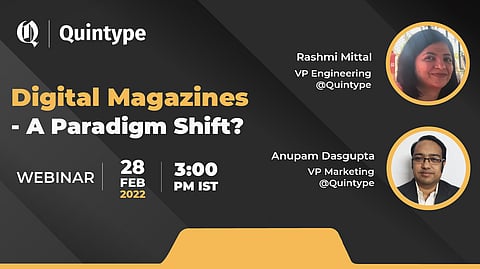Digital Magazines - A Paradigm Shift?
Written by: Rashmi
Traditional media is shifting to the digital world, and magazines are no exception. From the medium of publication to its business model –magazines are seeing a paradigm shift. In keeping with this spirit of facilitating the shift, Quintype conducted a webinar on “Digital Magazines - A Paradigm Shift?”
In the webinar, Mr. Dasgupta talked to Rashmi Mittal, Vice President of Engineering at Quintype and a well-known name in the product and technology space. The two experienced tech and marketing minds discussed the various aspects of magazines shifting from print to digital, including the difference between digital and print ads, revenue models, etc.
Speaking about the lagging evolution of print media, Ms. Mittal said that while news media has found a way to digitize its content and make new revenue models, print media is yet to establish its feet on the digital grounds. There is a niched, loyal readership of magazines that appreciates various aspects of print magazines, but the benefits of the digital world make it mandatory for print publishers to embrace the new methods of publishing.
Speaking from her years of experience in the digital space, Ms. Mittal found said that publishers benefit from the following after shifting from print to digital are:
The ability to change content on the fly
Reduction in the cost of magazines production and distribution
Larger outreach
Personalized content suggestion
She also added that as the magazines shift from print to digital ecosystem, they also have to keep in mind the end-user. Publishers can now use rich content such as visual stories, videos, audio, etc. They can create their own app to publish interactive content and garner the attention of the userbase.
Picking from her talk, the host asked about the difference between print ads and digital ads to which Ms. Mittal replied that print ads were there to put out the brand in front of readers. Full-page ads were the norm. But digital ads are different.
“The biggest thing is that you can have contextual ads. You can place them wherever you want in your layout and that turns out to be an asset. ‘Contextual’ is the big piece of it that people are betting on. It could be ads that are catered to you as a user, where your profile has been built. The returns from such ads are much better.”
The panel also discussed about the various formats of digital magazines PDFs, publishing articles on websites, apps, and so on.
Since a lot of legacy media publishers do not about the adaptation process, Mr. Dasgupta asked about how do the publishers make the shift. Answering that, Ms. Mittal said that for years, print publishers had a certain workflow that they have been used to. Their photographers upload the pictures to a certain system, their content writers simply write the content, and the designing team will put in the layout.
To shift to the digital world, publishers must have a digital-first approach where they create the content in the CMS and let it flow to the print system. Bold CMS offers the feature of publishing digital magazines on the same day when the print magazine is supposed to go out.
The in-house team of the magazine needs some training to get into the new workflow. Once they get used to the new CMS, there will be no need to write the content multiple times.
Moving towards the end of the session, the panel took some questions from the webinar chat and shared their view on the following:
Whether a magazine publisher should get a mobile app developed
Smart use of paywall by magazine publishers
Some creative ways through which digital publishers can come up with monetization
5 step blueprint for print-only publishers that they can follow and make the digital shift
If you are a digital publisher or a print publisher who is planning to shift to the digital space, you should definitely try our Bold CMS. From legacy media to new-age publishers, Bold caters to the needs of all kinds of publishers.

